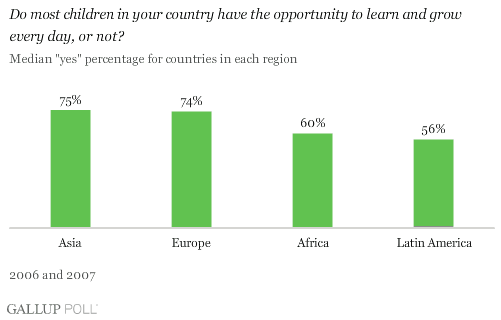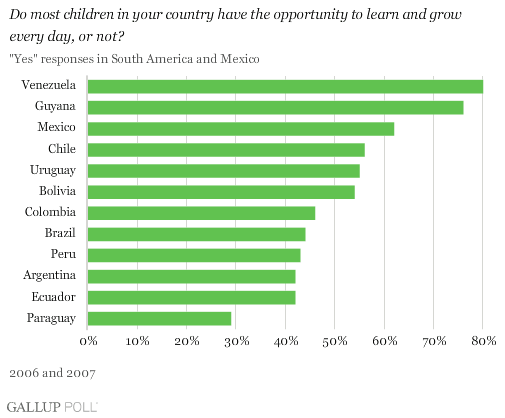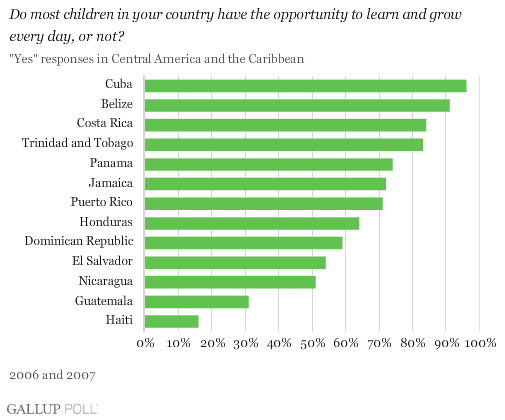WASHINGTON, D.C. -- Thanks largely to the rising price of commodities Latin America exports, the region has seen increased economic growth in recent years. Education is one area where this additional income is sorely needed: Gallup finds Latin Americans are less likely than residents of other global regions to say that most children in their country have opportunities to learn and grow every day.

Among the 25 Latin American countries Gallup surveyed in 2006 and 2007, the median proportion of those who respond affirmatively to this question is 56%. In Asia and Europe, the median percentage is about three-fourths of residents, while in Africa it is 60%.
Within the Latin American region, residents in many South American countries are more likely to respond negatively to this question than those from Central American or Caribbean countries. In 6 of the 11 South American countries studied -- including those with the continent's four largest populations: Brazil, Colombia, Argentina, and Peru -- fewer than half of residents say their country's children have opportunities to learn and grow on a daily basis.

In Central America and the Caribbean, results are on average more favorable. At least 8 in 10 respondents in Cuba (96%), Belize (91%), Costa Rica (84%), and Trinidad and Tobago (83%) say most children in their country have a chance to learn and grow every day.

Obstacles Facing Latin America's Children
In many parts of Latin America, the deck is stacked against a child's development from the start. Nils Kastberg, UNICEF's regional director for Latin America and the Caribbean, notes that widespread poverty leads to chronic malnutrition in the first few years of life, which often stunts children's physical and mental development. Across the 24 Latin American countries studied, a median 29% of residents say there were times in the past year when they didn't have enough money to buy food for their families.
Once children do reach school age, many face sharp inequalities in learning opportunities. Gallup asked respondents throughout Latin America if education in their country is accessible to anybody, regardless of their economic situation, and at least half of those surveyed in six Latin American countries say it is not accessible to anyone. Paraguayans and Haitians -- the populations least likely to say children have opportunities to learn and grow -- are also least likely to say education is accessible to anyone. Conversely, nearly all Cuban respondents (98%) and a vast majority of residents surveyed in Trinidad and Tobago (86%) and Venezuela (82%) say education is accessible to anyone. The median figure across 22 Latin American countries is 59%.

In some countries, concentrations of urban poverty severely limit development opportunities for children. For example, in Brazil, where impoverished favelas exist in almost every large or midsized city, the country's urban residents (37%) are less likely than rural residents (55%) to say children have the opportunity to learn and grow every day. Similarly, in Peru 35% of urban residents vs. 52% of those who live in rural areas say children have the opportunity to learn and grow every day.
Survey Methods
Results are based on face-to-face interviews with about 1,000 adults, aged 15 and older, in each of the 25 countries conducted in 2006 and 2007. For results based on each national sample, one can say with 95% confidence that the maximum margin of sampling error is ±3 percentage points. In addition to sampling error, question wording and practical difficulties in conducting surveys can introduce error or bias into the findings of public opinion polls.